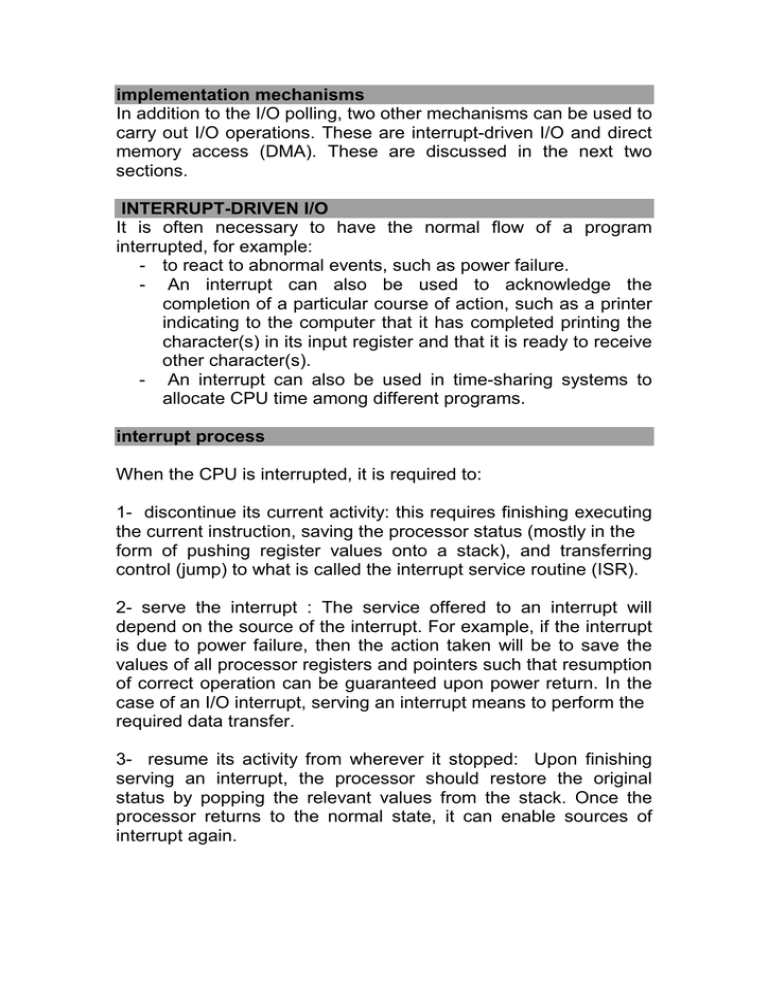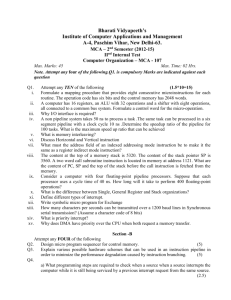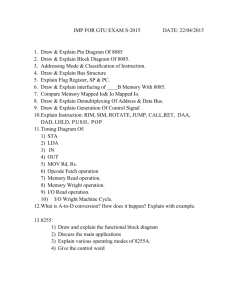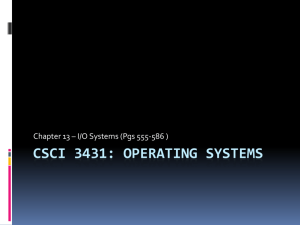implementation mechanisms
advertisement

implementation mechanisms In addition to the I/O polling, two other mechanisms can be used to carry out I/O operations. These are interrupt-driven I/O and direct memory access (DMA). These are discussed in the next two sections. INTERRUPT-DRIVEN I/O It is often necessary to have the normal flow of a program interrupted, for example: - to react to abnormal events, such as power failure. - An interrupt can also be used to acknowledge the completion of a particular course of action, such as a printer indicating to the computer that it has completed printing the character(s) in its input register and that it is ready to receive other character(s). - An interrupt can also be used in time-sharing systems to allocate CPU time among different programs. interrupt process When the CPU is interrupted, it is required to: 1- discontinue its current activity: this requires finishing executing the current instruction, saving the processor status (mostly in the form of pushing register values onto a stack), and transferring control (jump) to what is called the interrupt service routine (ISR). 2- serve the interrupt : The service offered to an interrupt will depend on the source of the interrupt. For example, if the interrupt is due to power failure, then the action taken will be to save the values of all processor registers and pointers such that resumption of correct operation can be guaranteed upon power return. In the case of an I/O interrupt, serving an interrupt means to perform the required data transfer. 3- resume its activity from wherever it stopped: Upon finishing serving an interrupt, the processor should restore the original status by popping the relevant values from the stack. Once the processor returns to the normal state, it can enable sources of interrupt again. multiple interrupts One important point that was overlooked in the above scenario is the issue of serving multiple interrupts, for example, the occurrence of yet another interrupt while the processor is currently serving an interrupt. Response to the new interrupt will depend upon the priority of the newly arrived interrupt with respect to that of the interrupt being currently served. If the newly arrived interrupt has priority less than or equal to that of the currently served one, then it can wait until the processor finishes serving the current interrupt. If, on the other hand, the newly arrived interrupt has priority higher than that of the currently served interrupt. It is possible to have the interrupting device identify itself to the processor by sending a code following the interrupt request. The code sent by a given I/O device can represent its I/O address or the memory address location of the start of the ISR for that device. This scheme is called vectored interrupt. Interrupt Hardware In the above discussion, we have assumed that the processor has recognized the occurrence of an interrupt before proceeding to serve it. Computers are provided with interrupt hardware capability in the form of specialized interrupt lines to the processor. These lines are used to send interrupt signals to the processor. In the case of I/O, there exists more than one I/O device. The processor should be provided with a mechanism that enables it to handle simultaneous interrupt requests and to recognize the interrupting device. Interrupt in Operating Systems When an interrupt occurs, the operating system gains control. The operating system saves the state of the interrupted process, analyzes the interrupt, and passes control to the appropriate routine to handle the interrupt. There are several types of interrupts, including I/O interrupts. An I/O interrupt notifies the operating system that an I/O device has completed or suspended its operation and needs some service from the CPU. To process an interrupt, the context of the current process must be saved and the interrupt handling routine must be invoked. This process is called context switching. A process context has two parts: - processor context : is the state of the CPU’s registers including program counter (PC), program status words (PSWs), and other registers. - memory context: is the state of the program’s memory including the program and data. The interrupt handler is a routine that processes each different type of interrupt. you will study O.S. interrupts in the 4th class in detail. DIRECT MEMORY ACCESS (DMA) The main idea of direct memory access (DMA) is to enable peripheral devices to cut out the “middle man” role of the CPU in data transfer. It allows peripheral devices to transfer data directly from and to memory without the intervention of the CPU. Having peripheral devices access memory directly would allow the CPU to do other work, which would lead to improved performance, especially in the cases of large transfers. The DMA controller is a piece of hardware that controls one or more peripheral devices. It allows devices to transfer data to or from the system’s memory without the help of the processor. In a typical DMA transfer, some event notifies the DMA controller that data needs to be transferred to or from memory. Both the DMA and CPU use memory bus and only one or the other can use the memory at the same time. The DMA controller then sends a request to the CPU asking its permission to use the bus. The CPU returns an acknowledgment to the DMA controller granting ()ﯾﻣ ﻧﺢit bus access. The DMA can now take control of the bus to independently conduct memory transfer. When the transfer is complete the DMA relinquishes its control of the bus to the CPU. Processors that support DMA provide one or more input signals that the bus requester can assert to gain control of the bus and one or more output signals that the CPU asserts to indicate it has relinquished the bus. The following figure shows how the DMA controller shares the CPU’s memory bus: DMA controller shares the CPU’s memory bus A DMA controller has : 1- address register: contains an address that specifies the memory location of the data to be transferred. It is typically possible to have the DMA controller automatically increment the address register after each word transfer, so that the next transfer will be from the next memory location. 2- word count register: holds the number of words to be transferred. The word count is decremented by one after each word transfer. 3- control register; specifies the transfer mode(burst mode or single cycle ). In burst mode, the DMA controller keeps control of the bus until all the data has been transferred to (from) memory from (to) the peripheral device. This mode of transfer is needed for fast devices where data transfer cannot be stopped until the entire transfer is done. In single-cycle mode (cycle stealing), the DMA controller relinquishes( )ﯾﺗ ركthe bus after each transfer of one data word. This minimizes the amount of time that the DMA controller keeps the CPU from controlling the bus, but it requires that the bus request/acknowledge sequence be performed for every single transfer. This overhead can result in a degradation of the performance. The single-cycle mode is preferred if the system cannot tolerate more than a few cycles of added interrupt latency or if the peripheral devices can buffer very large amounts of data, causing the DMA controller to tie up the bus for an excessive amount of time. A DMA controller may have multiple channels. Each channel has associated with it an address register and a count register. To initiate a data transfer the device driver sets up the DMA channel’s address and count registers together with the direction of the data transfer, read or write. While the transfer is taking place, the CPU is free to do other things. When the transfer is complete, the CPU is interrupted. Direct memory access channels cannot be shared between device drivers. A device driver must be able to determine which DMA channel to use. Some devices have a fixed DMA channel, while others are more flexible, where the device driver can simply pick a free DMA channel to use.







